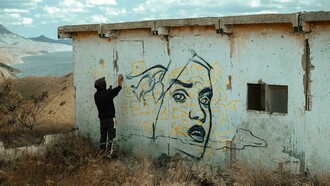An ever-evolving process of construction and reconstruction shapes the urban experience erecting an idea of social cohesion. Our daily lives, our movement from home to work, to the park, to the theatre may seem banal. But each action presents an invisible piece of development. Henri Lefebvre’s spatial theory put words to our relationships and perceptions to the spaces around us, both the built and natural environment; James Lomax blends the concepts back into the raw materials, distilling them and creating a tangible and visceral connection to the world in the making.
Entering the gallery space, the viewer is met with a piercing crack. Shocked by the initial burst of reaction by the inanimate, one stops and attempts to tread more carefully. A sea of thin cement tiles lay silently in wait. Each step leaves a trace, while our actions might seem to go unnoticed out in the real world, Details form the difference forces the viewers to engage in immediate cognizance of their effects. Cement tiles crack and crumble, shards stand alone apart from the whole and each subsequent step and movement exacerbates its difference. Fissures snake through the materials as visible ramifications. Better or worse is not the question, it is the influence and capacity, the human interaction with the inanimate which forms the context and essence.
Neutrality produces the space; varying shades of grey encompass the viewer in stripped down simplicity of raw materials. The bare bones on display present an unimpeded window into the framework we find ourselves. The urban environment is laid bare before us, but its blank canvas is a temporal state. Lomax removes the daily distractions giving us an opportunity to consciously consider our surroundings and our position within them.
The city seems to build up around us, but internal and external factors create its meaning. The physical and psychological purpose might seem to be branded into each piece of wood, each screw, and each coat of paint, but a tenuous existence flows through each particle. A malleable reality sits still as we create, continue, or deconstruct it. Lefebvre theorized about a spatial triad in the social production of space: Spatial Practice, Representations of Space, and Representational Space. Details from the difference address each, projecting us rapidly and candidly into the urban reality. Our interaction with the space is our spatial practice, what tiles lay broken underneath our feet? How many did we break, and how far in did we (dare to) go? The exhibition itself forms a “representation of space” as it serves as an ersatz form of the built environment of our urban existence. Most importantly, though, is the representational space.
The individual and collective efforts in the reconstruction of the materials builds a sense of unity. The whole cannot be recognized as one’s own, but attachment and affiliation is built out of the sense of agency inflected upon the entity — always ready to be deconstructed once more. While not intending to do so, the unique space of the Lily Brooke gallery enhances intimacy and the element of the individual experience of the exhibition. As a repurposed sitting room in a home, the gallery space provides the sense of familiarity and comfort, a fluid association between the viewer and the space and the work. There is an unconscious affiliation, which happens immediately, a realization of contextual thread between place and self, and the number of invisible threads within.
As time wears on, the viewer will step back out of the room. Out of the grey and off of the tiles. Ultimately, there will be one final, lasting impression made by the pressure of the individual interaction. From a step back, the effects will be seen … for a moment before the next juncture of pressure changes it yet again. In the end, the exhibition will be the creation of a communal performance, an amalgamation, an unforeseeable configuration of time, energy, movement, agency and even the lack of. Pieces make the whole and the whole dismantles into pieces. Details from the difference materializes a synecdoche of our urban reality — simplicity begets complexity.
James Lomax (b. 1991 Winchester) studied at the Ruskin School of Drawing and Fine Art, Oxford. In 2014 he was awarded a Sky Arts Academy Scholarship and more recently he has undertaken residencies at The New Art Gallery Walsall (in partnership with Eastside Projects) and Ikon Gallery, Birmingham. Alongside this show he is exhibiting in 'Th-th-th-that's all folks!' at the Castlefield Gallery, Manchester.















